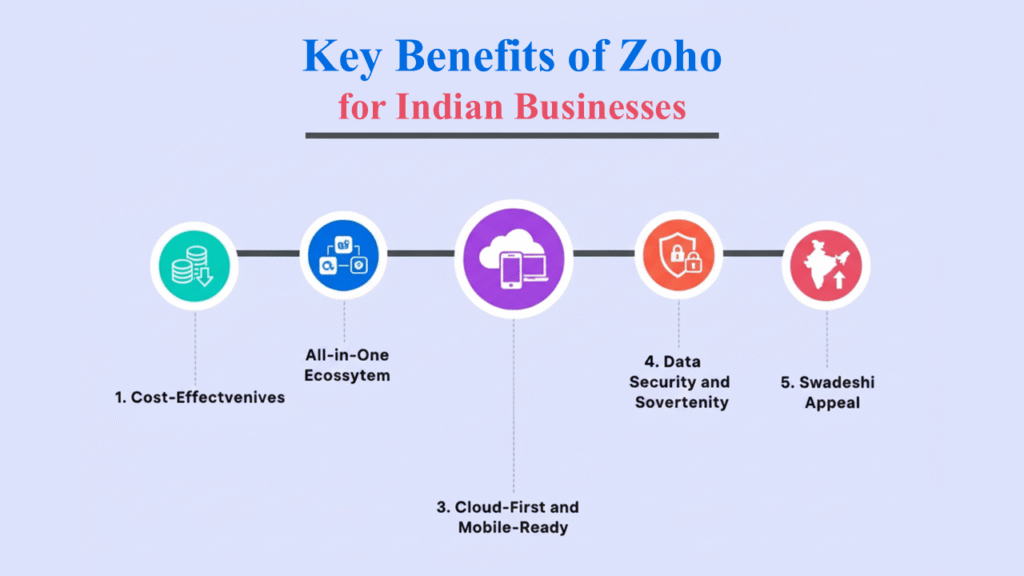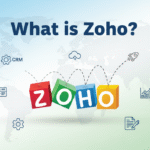
Discover why Indian businesses are making the big tech shift from Microsoft to Zoho. Explore the rise of Swadeshi platforms, key benefits of Zoho, and how it is shaping India’s digital future.
Table of Contents
Introduction
India’s digital economy is undergoing a historic transformation. For decades, global giants like Microsoft dominated the enterprise software ecosystem, shaping the way businesses managed operations, communication, and growth. But today, a powerful homegrown contender — Zoho — is rewriting that narrative.
What makes this shift so significant isn’t just about software preference; it reflects a broader movement toward Swadeshi platforms that embody self-reliance, affordability, and cultural alignment with Indian businesses. In a world where data sovereignty and cost-effectiveness are paramount, Zoho has emerged as more than just a Microsoft alternative — it has become a symbol of India’s rising technological independence.
Why India Is Shifting from Microsoft to Zoho
For years, Indian companies relied heavily on Microsoft’s suite of products such as Office 365, Azure cloud, and enterprise solutions. While undeniably powerful, these tools often came with high licensing costs and dependency on Western ecosystems.
Zoho, by contrast, offers:
- Affordable pricing models tailored for Indian businesses.
- Cloud-first architecture accessible to startups, SMEs, and large enterprises alike.
- Localized support and compliance aligned with Indian regulations.
- A Swadeshi identity, which resonates deeply with businesses seeking independence from foreign-dominated platforms.
The shift from Microsoft to Zoho is not about abandoning quality, but about embracing solutions that deliver value without compromising on features.
Key Benefits of Zoho for Indian Businesses

1. Cost-Effectiveness
Microsoft licenses can weigh heavily on startups and SMEs. Zoho disrupts this with subscription-based pricing models that are up to 60% cheaper than Microsoft equivalents. This affordability ensures even small-town entrepreneurs can access enterprise-grade tools.
2. All-in-One Ecosystem
Zoho isn’t just a CRM or a set of office tools. It’s an integrated suite of 55+ applications covering CRM, HR, finance, marketing automation, collaboration, and analytics. Businesses no longer need multiple vendors; Zoho provides a single ecosystem that scales with them.
3. Cloud-First and Mobile-Ready
With India’s mobile-driven economy, Zoho apps are optimized for accessibility on smartphones and tablets. Microsoft, though advanced, often requires higher-end systems or comes bundled with features many Indian SMEs may never use.
4. Data Security and Sovereignty
As India emphasizes data localization laws, Zoho’s Indian data centers give businesses peace of mind that sensitive information is managed under Indian jurisdiction. This is a strong edge over Microsoft, whose primary infrastructure is U.S.-centric.
5. Swadeshi Appeal
Beyond features and cost, Zoho carries the emotional advantage of being Indian-built and globally respected. For businesses that value Atmanirbhar Bharat (self-reliant India), this resonates strongly.
Zoho vs Microsoft: A Comparison
Features
- Microsoft: Renowned for Office Suite, Azure cloud, and enterprise-grade collaboration tools like Teams.
- Zoho: Excels in CRM, integrated business apps, and small-to-mid business scalability.
Pricing
- Microsoft: Higher upfront and subscription costs, especially for cloud-based enterprise tools.
- Zoho: Transparent, affordable, and flexible pricing tiers that fit startups and SMEs.
Ecosystem
- Microsoft: Offers powerful but often siloed products. Integration may require third-party tools.
- Zoho: Provides a natively integrated ecosystem, ensuring smooth workflows across apps.
Support and Localization
- Microsoft: Global-first approach with limited India-specific adjustments.
- Zoho: India-first, with strong focus on local business needs, compliance, and languages.
In short: Microsoft still dominates large enterprise software globally, but Zoho is rapidly positioning itself as the default choice for India’s next billion-dollar startups.
Zoho as a Swadeshi Platform for India’s Digital Future
When Prime Minister Narendra Modi emphasized Atmanirbhar Bharat, Zoho stood as a clear embodiment of that vision. Unlike many “Indian” tech companies that rely on global venture funding, Zoho has remained bootstrapped and profitable, building a sustainable growth story without external pressures.
Some highlights of Zoho’s Swadeshi ethos:
- Headquartered in Chennai with R&D centers in rural India.
- A strong focus on creating jobs in smaller towns and villages.
- Reinforcing India’s global image not just as a service provider, but as a product innovator.
This makes Zoho not just a tech tool, but a movement toward India’s self-sufficient digital future.
Conclusion: The Future Outlook
India’s big tech shift from Microsoft to Zoho is more than just a software preference — it’s a declaration of independence. By offering affordable, scalable, and Swadeshi business solutions, Zoho is paving the way for India to become not just a consumer of technology but a global leader in digital innovation.
As more Indian startups, SMEs, and even enterprises embrace Zoho, the question is no longer “Can Zoho replace Microsoft?” but rather “How fast can Zoho scale to become the world’s next Microsoft?”
In the coming decade, Zoho is likely to stand as both a symbol of India’s digital sovereignty and a practical tool for businesses worldwide. The rise of Zoho isn’t just about competition; it’s about reshaping the global tech landscape with Swadeshi strength.
❓ Frequently Asked Questions (FAQs) about Zoho and India’s Tech Shift
1. Why are Indian businesses shifting from Microsoft to Zoho?
Indian businesses are moving to Zoho because it offers affordable pricing, an all-in-one ecosystem, localized support, and compliance with Indian regulations. Unlike Microsoft, Zoho is a Swadeshi platform that resonates with India’s push for self-reliance.
2. Is Zoho really a replacement for Microsoft?
Zoho may not replace Microsoft in every area, but it serves as a strong alternative for startups, SMEs, and even enterprises. With 55+ integrated apps, Zoho covers CRM, office productivity, finance, HR, and more, making it a complete business suite.
3. How is Zoho different from Microsoft?
- Microsoft: Global giant with enterprise-grade software, higher pricing, and global-first infrastructure.
- Zoho: Homegrown Indian company offering affordable, cloud-first, integrated solutions with strong local focus.
4. What makes Zoho a Swadeshi platform?
Zoho is headquartered in India, develops products locally, runs R&D centers in rural areas, and remains bootstrapped and independent. This aligns with India’s Atmanirbhar Bharat vision of self-reliance.
5. Is Zoho suitable only for small businesses?
No. While Zoho is popular with SMEs and startups, it also scales for large enterprises. Its suite includes enterprise-grade tools for CRM, analytics, and cloud services, making it suitable for all business sizes.
6. Does Zoho provide better value than Microsoft?
Yes, for most Indian businesses. Zoho provides cost-effective subscription models that are often 40–60% cheaper than Microsoft. Combined with its integrated ecosystem, Zoho delivers higher value for growing businesses.
7. What are the challenges Zoho faces compared to Microsoft?
Zoho’s main challenges include competing with Microsoft’s global dominance, scaling for Fortune 500 companies, and changing perceptions that “foreign software is better.” However, Zoho’s Swadeshi appeal and innovation help it stay competitive.
8. Can Zoho compete globally with Microsoft?
Yes. Zoho already serves 100+ million users worldwide, proving its global reach. With a growing focus on data privacy, affordability, and cloud solutions, Zoho is well-positioned to challenge Microsoft internationally.

